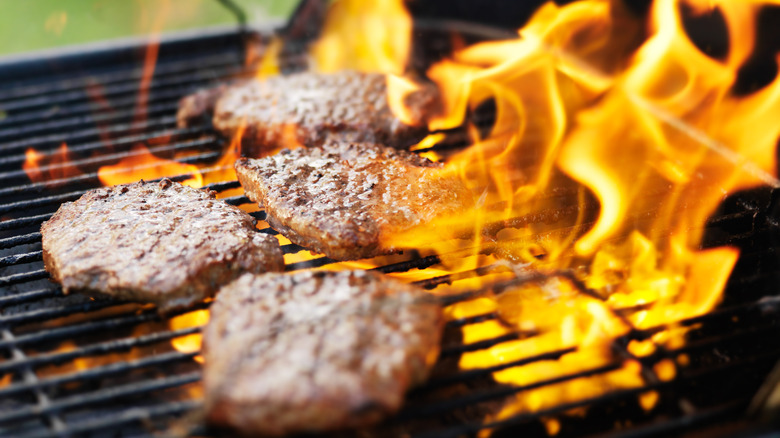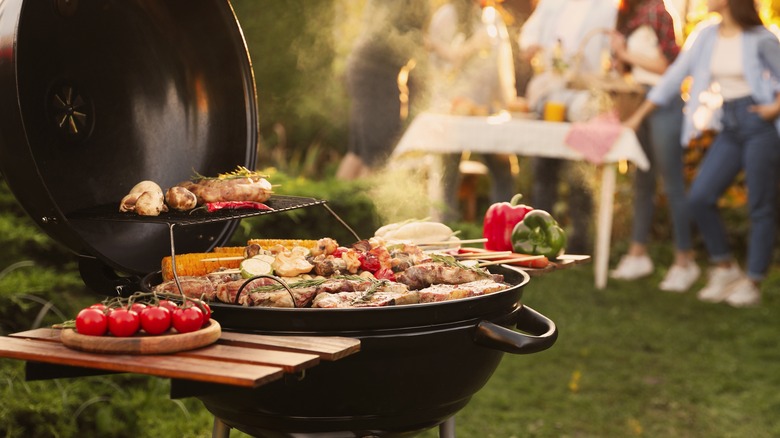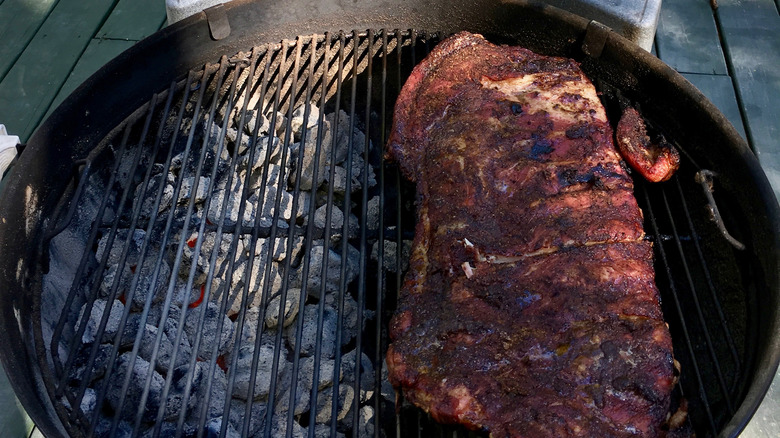How To Deal With Grilling Flare Ups Like A Pro
A perfectly charred burger doesn't have to come at the price of your eyebrows. Fending off flare ups — the spikes of fire that crop up on the grill when flipping meat and laying down oily marinated vegetables — is not a requirement of the job. Taming them takes quick thinking, but they're easier to handle than you might realize.
The first and easiest tactic when your dinner is suddenly engulfed in flames is to simply move the food. It's fine to wait out a quick spark of orange, but if you find your hot dogs and corn cobs are lost to heat and smoke, shift them to a cooler or cleaner part of the grate. Sometimes a flammable chunk of garlic or accumulation of grease can trigger a quick rush of heat, and you can adjust by sliding the food to another area and cleaning the grill after you're done cooking.
If the height of the flames look something like lighter fluid just hit the coals or gas, you may have to take Chef Bobby Flay's advice on grilling and close the top. This will help reduce the flow of oxygen and bring down the volume of the flames, ultimately protecting patios and delicate hands. Once the flare burns itself out, cookouts can resume as normal. If you're not having any luck, take more drastic measures by turning off the gas, dousing the grill with baking soda, or even reaching for a fire extinguisher. One thing you don't want to do, though, is spray the surface with water, as this can spread the fire or produce burning hot steam.
What causes grill flare ups?
Although many chefs know alcohol plus fire equals a dramatic flambé, when it comes to the grill, fats cooking directly over the coals can be blamed for he sparks. Flare ups happen when you're moving meat and those lipid-rich juices are squeezed out, as well as after an olive oil vinaigrette hits the flame. This is totally normal, and moderate flares actually help build flavor. However, too much of a good thing can cause your food to veer into burnt territory. In particular, sugary sauces, fruits, and vegetables are quick to burn rather than char or caramelize.
To reduce the risk of mile-high fires, cooks should grill strategically. Rather than slapping a piece of food onto the grate, take the time to shake off any excess fat and baste with care. The same goes for deliciously marbled meat. Trim off the fat cap to get to about a quarter- to half-inch, depending on how much you're willing to lose. It will be worth it when you produce a glossy, medium-rare steak.
Whatever you do, don't leave a fatty piece of meat engulfed in fire for the entire cooking time. This just messes with your timing and can lead to an overcooked or overwhelmingly smoky, dried out meal. To get the best results, stay close in case a big drip of grease lights up and compensate for the change in temperature. And be sure to clean grates with an onion or another tool before your next cookout.
Exploring direct and indirect heat
Grilling pros know how to adjust the position of burger patties when a nasty flare strikes, but less experienced cookout hosts may not have set up their station for this scenario. The secret is to embrace two-zone grilling. Rather than urging coals or propane to reach scorching temperatures, many cooks will build the flame on one end of the equipment. They'll keep the other end at a low heat (or even unheated) by turning off the gas or banking the coals far away.
This technique is also called direct and indirect cooking. Indirect is helpful for low-and-slow smoky BBQ staples, while direct cooking nails the quick sear needed to char thinner, leaner proteins or add a reverse sear to caramelize finished foods. The top of the grill usually stays open when cooking directly, whereas grillers will shut the lid when utilizing the low heat to stabilize the temperature and hold in those aromas.
Make sure not to set-and-forget your food, no matter how you utilize the different zones. You'll want to flip whole birds and rotate unhusked corn no matter how well you soaked the ingredients — just try not to open the lid every few minutes when using indirect heat. A meat thermometer also helps keep cooks on track, taking some of the guesswork out of the process.



